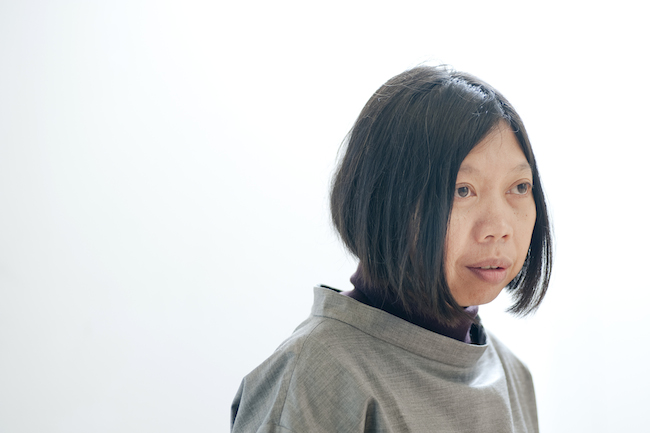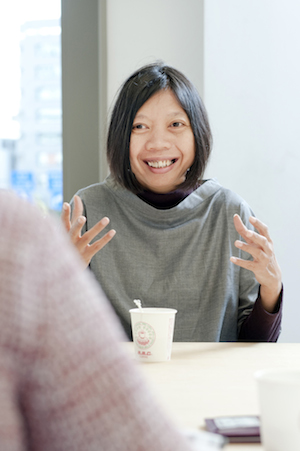Programming that Reflects the Current Situation of Indonesian Dance Scene
How do you organize the dance program?
Helly: I had thought that I was an outsider of the dance community until recently, because most dance practitioners have more or less similar experiences or trajectories than I do. For example, most start as a traditional dancer, and enter a national dance academy in Jakarta, Solo, Bandung or Yogyakarta. After graduating, they become a professional dancer, choreographer or teacher etc etc. My background is different, zigzagging, and I was aware that some people in the dance world might see me as someone who knows more about international scenes than the local things. This was one of my motivations to study about the history of Indonesian dance and its current practice. Dance involves a lot of issues, a lot of problems. I think, we better look for solutions through a long process with a clear objective, direction and patience instead of trying to solve all those many problems at the same time as some tend to. What I think is the urgent problem now is the lack of critical thoughts in Indonesia dance scene after all those process of institutionalization through national academies and other national projects. At the Council, for instance, we have been inherited by a project called "Maestro! Maestro!" It is a platform where senior dancers are re-introduced as 'masters' but we now change it to be a platform to discuss critically about the traditional dance forms, and the 'master' is just a vehicle to discuss it widely. We thus changed the name from Maestro! Maestro! to "Telisik Tari" which roughly means 'investigating dance'. The platform is now is as such that it's not only for merely glorifying the masters but also for discussing many critical issues of traditional dance in the background: the form, what has changed and what has not changed, or challenging the idea that tradition cannot be altered. Indeed, tradition is to be passed on, but along the way, we can also change the concepts and create our own tradition. We also do a better documentation. Dance criticism has not been well developed, so we have a plan to ask critics for contributions and publish an anthology of Indonesian dance studies on top of selection the old/historical articles/writing. We shall read the critical writings in the 1970s to understand what led us to the current situation. Also, we have launched a project for emerging choreographers called Choreo-Lab: Process in Progress. I researched myself in the beginning. I traveled to see performances, selected three prospective young choreographers, and gradually established a small "academy".

What kind of academy is it?
Helly: It's academy in the informal sense. The three choreographers selected in the first batch last year create very differently: one uses text, another works on language of the bod. We invited them to Jakarta for a four day workshop and had them work with two main facilitators, one is Suprapto Suryodarmo known for his Amerta movement approach and another is Hanafi, a visual artist who has worked with theatre and contemporary dance context. Hanafi has a beautiful studio in outskirt Jakarta where the workshop take place - far from the city hustle bustle. Then we invited sources from non-dance backgrounds such as from film, theatre and literature.
Are they like mentors?
Helly: Yes. This year we repeat the program with the same two mentors and some adjustment. Let's see how it pans out.
Curation for International Dance Festivals
You have also been involved in various projects as a curator in the field of international exchange.
Helly: My first work abroad as a curator was for Asia-Europe Dance Forum in Berlin in 2004. I was still in Beijing doing my ASF residency, but Marie Le Sourd, who was in Asia-Europe Foundation then and currently Secretary General of On the Move, made me the offer. I immediately accepted it, but again, I realized that I didn't know anything about Asia and Asian dance artists. I meant it as way of learning by doing. One of the curators, Bettina Masuch, had already conceived the framework and proposed "Mis/Understanding" as the theme. Her idea was, "Asia and Europe have always misunderstood each other, so let's start over by becoming honest." I agreed. We invited 16 choreographers and one of them choreographer / performance maker Mikuni Yanaihara from Japan for the edition. I also participated as a co-curator in the 2006edition of Monsoon in Korea, a 2-week exchange between Asian and European artists initiated by choreographer Arco Renz and his Kobalt Works company. It didn't specifically focused on dance, so from Indonesia, I sent a theatre artist to the Forum.

And then Indonesian Dance Festival (IDF). I took part in it in 2014 as a co-curator. IDF received a large financial support from the city for the first time in 2012, the previous edition which happened to be the 20th year of the festival. The Singaporean curator/producer Tang Fu Kuen and Japanese dance critic Daisuke Muto had already been invited to the curatorial committee since 2006 and 2008 respectively. To be brutally honest, I think that 2012 program lacked critical thought although secured a good funding due to the fact that there was a gap of vision between what the Indonesian curators and the international ones tried to show. Firstly I was reluctant whether I could do better since IDF already have a certain work-culture that they established from its founding back in 1992 which is so different than mine. We discussed it for months, and I finally agreed simply because Daisuke talked me into it. He met Fu Kuen and the two IDF key leaders, Maria Darmaningsih and Nungki Kusumastuti, during the Attakalari Festival in Bangalore in 2013. They discussed, and after Daisuke proposed for IDF to establish a consulting committee in addition to the curatorial one. I was to be positioned in the middle, someone who sits in both curatorial board and the consulting board. And that I would have a say in forming the latter, so I invited colleagues from non-dance backgrounds such as poet/playwright/critic Afrizal Malna who had worked with choreographer Fitri Setyaningsih for nine years; Ade Darmawan from ruangrupa collective, Seno Joko Suyono from Tempo magazine (critic) and Tony Prabowo, the dance curator for Salihara collective. I think my work at IDF was about "connecting" the international context, which Fu Kuen and Daisuke proposed, adding mine, and the local contexts.






